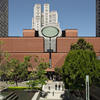More about Lesende (Reader)
- All
- Info
- Shop

Contributor
Gerhard Richter’s Lesende could easily be mistaken for a photograph.
Lesende (the German word for "reading") is a photorealistic painting. Richter first experimented with this style of painting in 1962, when he painted directly from photographs and onto canvas. Richter doesn’t care if you think taking a photograph would be less time consuming. No duh. What Richter really wanted to achieve in his career was an ability to paint like Vermeer, of whom you could say Richter is a superfan, describing him in a 2002 interview as an "artist-god." This makes sense, as it has been theorized that Vermeer used a 'camera obscura,' a box with a hole or "lens" in one side, and a series of mirrors to achieve photorealistic detail in his work. Lesende is an appropriate homage to paintings by Richter's idol, with its sense of quietude, dreamlike sheen, and the use of dramatic light and dark (or chiaroscuro, if you fancy).
The subject of Lesende is the artist Sabine Moritz, Richter’s third wife. Love blossomed in 1992, when the pair met at Kunstakademie, where Moritz was his student. Moritz has since been a subject of Richter’s on multiple occasions, and there are even two named Lesende. The second shows this same scene but at an angle, focusing mostly on the back of Moritz’s head. The images of his wife are intimate and family oriented, another aspect shared with Vermeer.
Sabine Moritz grew up in East Germany. So disparate were the east and west of Germany that when Moritz moved there with her family, she felt a foreigner despite speaking the same language. Moritz was in Richter’s last class at Kunstakademie. In the end, Moritz went from student to muse, and the pair married in 1995, a year after Richter painted Lesende. Nowadays, Richter often turns to Moritz for critical feedback for his paintings, trusting in her judgement. She shares a studio loft with Richter in Cologne, where they have been creating art for ten years.
Sources
- Albers, Kate Palmer, Uncertain Histories: Accumulation, Inaccessibility, and Doubt in Contemporary Photography. Oakland: University of California Press, 2015.
- Carol Kino, “Canvas collection: Gerhard Richter’s brush with greatness,” The Wall Street Journal, June 14, 2016. Date accessed May 22, 2020. https://www.wsj.com/articles/canvas-collection-gerhard-richters-brush-w…
- Coerver, Chad, SFMOMA Painting and Sculpture Highlights. San Francisco: San Francisco Museum of Modern Art, 2002.
- Farago, Jason, “SFMOMA review: it’s art history on steroids but must go beyond big names,” April 30, 2016. . Date accessed May 22, 2020. https://www.theguardian.com/artanddesign/2016/apr/29/sf-moma-review-war…
- Fer, Briony, “Chrono-Technics: Richter’s Family Pictures,” Gerhard Richter: Painting After All, editor Sheena Wagstaff. New York: Metropolitan Museum of Art, 2020.
- O’Donovan, S.J., Leo J. “Saying goodbye to a master: a virtual visit to Gerhard Richter at the Met Breuer,” America The Jesuit Review, May 15, 2020. Date accessed May 22, 2020. https://www.americamagazine.org/arts-culture/2020/05/15/saying-goodbye-…-
- Storr, Robert, Gerhard Richter: Forty Years of Painting. New York: The Museum of Modern Art, 2002.
- Karen Wright, “Sabine Moritz, painter: ‘Having grown up in East Germany, I feel like a dinosaur,” Independent, November 12, 2015. Date accessed May 22, 2020. https://www.independent.co.uk/arts-entertainment/art/features/sabine-mo…-
- Gerhard Richter, "Interview with Babette Richter, 2002" from Gerhard Richter: Text. Writings, Interviews and Letters 1961-2007 (Thames & Hudson: London, 2009) p.443














